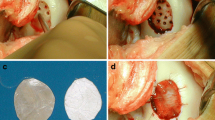Abstract
Microfracture used to treat articular cartilage injuries can facilitate access to stem cells in the bone marrow and stimulate cartilage regeneration. However, the regenerated cartilage is fibrocartilage as opposed to hyaline articular cartilage and is thinner than native cartilage. Following microfracture in rabbit knee cartilage defects, application of hyaluronic acid gel resulted in regeneration of a thicker, more hyaline-like cartilage. The addition of transforming growth factor-β3, an inducer of chondrogenic differentiation in mesenchymal stem cells, to the treatment with microfracture and hyaluronic acid did not significantly benefit cartilage regeneration.




Similar content being viewed by others
References
Buckwalter JA (1998) Articular cartilage: injuries and potential for healing. J Orthop Sports Phys Ther 28:192–202
Buckwalter JA, Mankin HJ (1997) Articular cartilage. Part II: degeneration and osteoarthrosis, repair, regeneration, and transplantation. J Bone Joint Surg Am 79:612–632
Dorotka R, Windberger U, Macfelda K et al (2005) Repair of articular cartilage defects treated by microfracture and a three-dimensional collagen matrix. Biomaterials 26:3617–3629
Frisbie DD, Trotter GW, Powers BE et al (1999) Arthroscopic subchondral bone plate microfracture technique augments healing of large chondral defects in the radial carpal bone and medial femoral condyle of horses. Vet Surg 28:242–255
Frisbie DD, Oxford JT, Southwood L et al (2003) Early events in cartilage repair after subchondral bone microfracture. Clin Orthop Relat Res 407:215–227
Gudas R, Kalesinskas RJ, Kimtys V et al (2005) A prospective randomized clinical study of mosaic osteochondral autologous transplantation versus microfracture for the treatment of osteochondral defects in the knee joint in young athletes. Arthroscopy 21:1066–1075
Hunziker EB (2002) Articular cartilage repair: basic science and clinical progress. A review of the current status and prospects. Osteoarthritis Cartilage 10:432–463
Kuo AC, Rodrigo JJ, Reddi AH et al (2006) Microfracture and bone morphogenetic protein 7 (BMP-7) synergistically stimulate articular cartilage repair. Osteoarthritis Cartilage 14:1126–1135
Lammi PE, Lammi MJ, Tammi RH et al (2001) Strong hyaluronan expression in the full-thickness rat articular cartilage repair tissue. Histochem Cell Biol 115:301–308
Majumdar MK, Banks V, Peluso DP et al (2000) Isolation, characterization, and chondrogenic potential of human bone marrow-derived multipotential stromal cells. J Cell Physiol 185:98–106
Prakash D, Learmonth D (2002) Natural progression of osteo-chondral defect in the femoral condyle. Knee 9:7–10
Shapiro F, Koide S, Glimcher MJ (1993) Cell origin and differentiation in the repair of full-thickness defects of articular cartilage. J Bone Joint Surg Am 75:532–553
Solchaga LA, Yoo JU, Lundberg M et al (2000) Hyaluronan-based polymers in the treatment of osteochondral defects. J Orthop Res 18:773–780
Steadman RJ, Rodkey WG, Singleton SB et al (2001) Microfracture procedure for treatment of full-thickness chondral defects: technique, clinical results, and current basic science status. In: Harner CD, Vince KG, Fu FH (eds) Techniques in knee surgery. Lippincott Williams & Wilkins, Philadelphia, pp 23–31
Steadman JR, Briggs KK, Rodrigo JJ et al (2003) Outcomes of microfracture for traumatic chondral defects of the knee: average 11-year follow-up. Arthroscopy 19:477–484
Wei X, Gao J, Messner K (1997) Maturation-dependent repair of untreated osteochondral defects in the rabbit knee joint. J Biomed Mater Res 34:63–72
Acknowledgement
This work was supported by a research fund from Hanyang University (HY-2006-I), South Korea.
Author information
Authors and Affiliations
Corresponding authors
Rights and permissions
About this article
Cite this article
Kang, SW., Bada, L.P., Kang, CS. et al. Articular cartilage regeneration with microfracture and hyaluronic acid. Biotechnol Lett 30, 435–439 (2008). https://doi.org/10.1007/s10529-007-9576-2
Received:
Revised:
Accepted:
Published:
Issue Date:
DOI: https://doi.org/10.1007/s10529-007-9576-2




